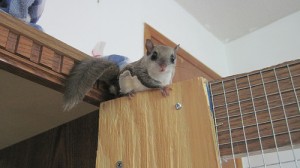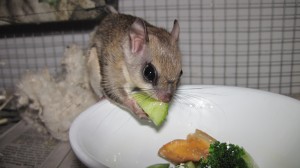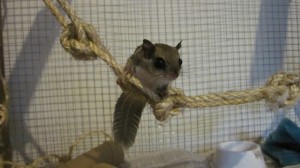Many people may have never even seen one, but the Southern flying squirrel, Glaucomys volans, is widespread across much of the eastern United States reaching upwards into southern Canada. This nocturnal squirrel spends its days sleeping and its nights gliding effortlessly through the tree tops in search of nuts and the occasional bug. These small squirrels can grow to a length of 8-10 inches, weigh just over 4 ounces and live upwards of 12 years.
A frequent inhabitant of deciduous forests, flying squirrels often nest in abandoned woodpecker nests. During the spring and fall breeding season the adult female Southern flying squirrel will produce a litter of 3-7 pups which will stay with mother for several months. The male flying squirrel does not remain with or assist in the rearing of the offspring.
During the winter flying squirrels will huddle together in large communal nests, sometimes with populations numbering over two dozen squirrels, in an effort to keep warm throughout the harsh winter. Although flying squirrels do not hibernate, if temperatures become too severe the squirrels will enter a state of torpor until temperatures return to normal.
Carnivorous Flying Squirrels?
The diet of the Southern flying squirrel consists mainly of nuts, berries, mushrooms, small insects, carrion, the eggs of birds and occasionally fledglings. Because their teeth continuously grow they must constantly gnaw on wood to keep them down to a manageable size. Wild flying squirrels are generally healthy and not prone to disease. Those that are kept in captivity often have issues with metabolic bone disorder from lack of a proper diet.
The Southern flying squirrel is smaller than its cousin, the Northern flying squirrel, and their territories do overlap in some areas. The Southern flying squirrel is more aggressive than its larger northern cousins, but the true danger of their interactions lie in the transmission of a parasite sometimes carried by the Southern flying squirrel that is fatal to the Northern flying squirrel.
Predators of the Southern flying squirrel include owls, coyotes, cats, raccoons and snakes. The one benefit that the flying squirrel has in escaping predators is its ability to glide over long distances, up to 100 yards. Their nocturnal tendencies keep them off the radar of hawks and other diurnal birds of prey.
Fliers or Gliders?
Flying squirrels have a loose flap of skin, referred to as the patagium, that stretches from wrist to ankle enabling them to glide from treetop to treetop. When in flight their long flat tail acts as a rudder and stabilizer allowing them greater control for steering around obstacles and making precision landings. The squirrel usually lands on its back feet first and using the patagium to parachute them into a softer landing.
Southern flying squirrels usually have a a light tan to gray colored upper body with a white or cream colored underbelly that is separated by a darker stripe along the patagium. They have prominent round eyes designed specifically for their nocturnal activities and they have excellent hearing. They are able to communicate through a series of chirps, clicks and whistles, many of which are above the range of human hearing.
The Southern flying squirrel is not endangered as a species although it is listed as endangered or threatened in some states. The flying squirrel has managed to find its way into the pet trade where it has become a favorite among small animal lovers. The Southern flying squirrel, or SFS, is not particularly prone to disease and its temperament allows it to bond quite well with its human owners.
Additional Resources:
Journal of Wildlife Diseases 2 June, 2003. Web 17 Nov. 2009




Test post